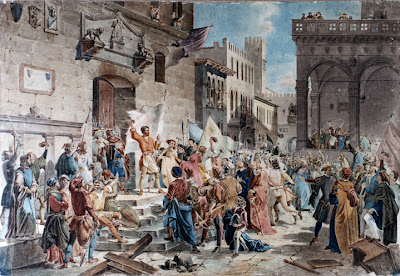THE REBELLION OF THE CIOMPI
Let's learn some history together!

Walking through the streets of Florence, you may easily arrive at the main square the Piazza della Signoria, with its magnificent statue of Neptune, its glorious Perseus holding the head of Medusa, listening to some street musician and admiring the entrance of the ancient Palazzo Vecchio. In 1378 Florence, something extraordinary happened: the rebellion of the Ciompi. Why is this historical fact so particular, you may ask. Now close your eyes. Let's travel back of almost 700 hundred years to 1378 Florence. At that time, Italy was divided into communes, where big cities as Venice, Rome, Naples and Florence were the centre of commerce, art and politics. The Rebellion of the Ciompi represents the first biggest proletarian urban revolt. This is the reason why it has become the object of so many studies since the 19th century when the Marxist and socialist thesis and philosophy were beginning to spread across Europe. The Revolt of the Ciompi was a rebellion among unrepresented labourers which occurred in Florence, Italy from 1378 to 1382. Those who revolted consisted of artisans, labourers, and craftsmen who did not belong to any guilds and were therefore unable to participate in the Florentine government. These labourers had grown increasingly resentful over the established patrician oligarchy. They were also expected to pay heavy taxes which they could not afford, forcing some to abandon their homes. The resulting insurrection over such tensions led to the creation of a government, controlled by wool workers and other disenfranchised workers which lasted for three and a half years.
Learn more about the Ciompi Rebellion on Wikipedia 📚
This page was coded by Elisa Querini